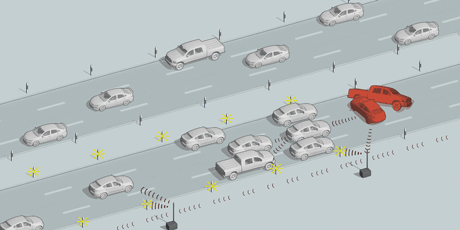by Josef Jiru
Of the 2.36 million traffic accidents recorded in Germany in 2011, traffic congestion and tailgating caused the most injuries. Because they are usually positioned at one to two kilometer intervals, conventional traffic control systems do not adequately warn drivers of sudden danger situations. When positioned between the systems, drivers must rely solely on their own perception of the situation. To address this issue, Fraunhofer ESK is working with Ruetz Technologies and TRANSVER to develop an autonomous traffic warning and information platform that can more quickly detect critical situations and provide precise local warnings through finer granularity.
The combination of various sensors enables much faster and more reliable detection of critical situations on high-speed roads through autonomous stations on the edge of the road (road side units or RSU). Fraunhofer researchers designed the system which utilizes a combination of stationary sensors, such as radar or measuring loops, and information relayed from vehicles.
The system analyzes the data and identifies potentially dangerous situations such as the sudden appearance of road construction sites, traffic back-ups, the presence of objects on the road or inclement weather. Drivers are informed of the precise location of the danger through warning lights integrated in the reflector posts and directly via car-to-x communication.
The data gathered by the system must be processed in real-time. The main task involves merging the data generated by various sources in order to create a consistent overview of the traffic situation. Matching the information from multiple sensors covering the same area ensures a high level of data quality at the source. Furthermore, local as well as remote data is aggregated depending on the current network capacity and needs of the application scenario, and then forwarded. The system's modular design enables the transparent use of different sensor technology.

From sensor measurement to warning light
Traffic data, such as the position and speed of individual vehicles, is recorded within a dense grid, merged if needed, and then transmitted via wireless technology to a higher-level control unit (remote terminal unit or RTU). The RTU uses the accumulated information to ascertain the current traffic situation in real-time. If the system identifies a problem that could lead to a dangerous situation for traffic heading in a given direction, drivers are given a heads-up via warning lights that will blink with a standardized pattern. If appropriately equipped, vehicles can also directly receive standardized DEN messages and display traffic warnings. This raises the level of awareness among traffic participants in this particular grid. Direct car-to-x messages are transmitted directly via ETSI ITS-G5 technology and give the drivers more detailed information on the position and nature of the danger ahead, e.g. a broken down vehicle or the end of a traffic jam. Fraunhofer ESK is creating a heterogeneous network concept for communication between vehicles, infrastructure and RTUs in which the data are aggregated in an adaptive manner. The concepts and processes are validated in a simulation environment and then implemented with in-house developed software and hardware on a test route.
ezCar2X Framework
To easily generate these kinds of driver assistance systems, Fraunhofer ESK developed ezCar2X, a flexible software framework that creates the key components for rapidly developing prototype applications for use in vehicle-to-environment networking. This enables vehicle manufacturers, suppliers and road infrastructure operators to quickly implement new ideas and test them in a near-real environment.
The Fraunhofer ESK car-to-x framework ezCar2X features components for the following functions:
- ETSI ITS-compliant communication services, including ITS G5 and GeoNetworking
- CAN bus interface for fast integration into the vehicle
- Interfaces to external sensors, including GPS, speed or object tracking
- Digital map integration
- Facilities such as CAM and DENM management and precise determination of the vehicle’s own position
- Interfaces for connecting various HMI devices such as tablets and touch screens.
The framework is a collection of C++ libraries that are available for Linux and Windows systems. Extensive API documentation and various examples speed up the learning curve. The software components were designed with a low degree of interdependency to enable them to be combined as needed. Unused functions do not create an additional load on resources at runtime. The consistent use of abstract concepts and known design patterns leads to a high degree of modularity. Individual functions can be swapped and replaced by other implementations if needed without having to modify the remaining system.
The project is funded by the Bavarian Ministry of Economic Affairs, Infrastructure, Transport and Technology.
Link: http://www.esk.fraunhofer.de/en/projects/VIP.html
References:
[1] K. Roscher, et al: “ezCar2X: a modular software framework for rapid prototyping of C2X applications”, 9th ITS European Congress, Dublin, Ireland, 4-7 June 2013
[2] T. Steiner, K. Roscher, J. Jiru: “Cooperative Glare Reduction Using V2V Radio Technology”, 5th International Symposium on Wireless Vehicular Communications: WIVEC2013, 2-3 June 2013, Dresden, Germany
Please contact:
Josef Jiru
Fraunhofer Institute for Communication Systems ESK, Germany
E-mail:











